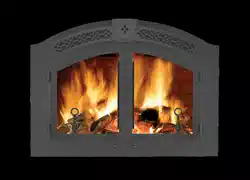Loading ...
Loading ...
Loading ...

W415-1501 / E / 12.17.18
EN
34
9.0 operation
9.1 operating sounds and smells
9.2 fi re extinguishers, smoke detectors and carbon monoxide detectors
TIPS FOR BURNING:
• Create a large fi re to heat up the appliance before closing bypass door and adjusting to a slower burn.
• To create a large, quick burning fi re, use small pieces of wood.
• For a lower, but, extended burn, stack larger pieces of wood close together.
• For long burns, leave a 1” (25mm) - 2” (51mm) bed of ashes.
• Burn dry wood only.
• With the exception of overnight burns, create large, quick burning fi res whenever possible. Smaller, slow
burning fi res using large logs will cause the glass to become dirty. Larger, quick burning fi res using medium
sized wood to refuel frequently are much more effi cient.
• It is important to minimize visible smoke emitting from the chimney. Burning seasoned fi rewood, maintaining
the appliance catalyst and following the operating instructions contained within this manual will ensure that
visible smoke emissions are minimized.
Expansion / contraction noises during heating up and cooling down cycles are normal and to be expected.
DO’S
• Verify with a moisture meter that wood contains no
more than 20% moisture content.
• Burn several pieces of medium sized wood as they
are better than a few big pieces.
• Clean chimney regularly.
• Refuel frequently using medium sized wood.
• “Fine tune” the air settings (if applicable) for optimum
performance.
DONT’S
• Take ash out immediately. Let it accumulate to a
depth of at least one inch. A good ash layer provides
for a longer lasting and better burning fi re.
• Burn wet wood with more than 20% moisture
content.
• Close the door too soon or damper down too
quickly.
• Burn one large log rather than two or three smaller
sized logs.
• Burn at continually “low setting” (if applicable), if
glass door is constantly blackened. This means the
fi rebox temperature is too low.
If a blower is installed, slight humming sound may be heard depending on the location of the blower. The sound may
be minimized by turning down the blower speed. It is also normal during operation to hear creaking and/or ticking
sounds as the metal plate components of the appliance expand and contract. This may be present during both
warm up and cool down periods.
During the break-in period (the fi rst 2 or 3 fi res) create only small, hot fi res using kindling. This will allow the fi rebrick
to cure. Do not be alarmed if small hairline cracks develop in the fi rebrick. This is a normal occurrence and does not
pose a safety hazard. During this time the paint may also emit an odour as it cures and you may wish to open a door
or window to alleviate the smell.
There are many different ways to start a fi re, review the hints and warnings in this section to ensure the fi re is started
properly.
!
WARNING
• This appliance emits carbon monoxide (CO), a colourless and odourless gas that can lead to severe illness and
even death if exposed to human or animals in suffi cient quantities.
• The use of this appliance in a manner inconsistent with the operating instructions contained in this manual can
signifi cantly increase the emission of smoke and carbon monoxide (CO). Therefore, we recommend you install
detectors in areas that could be susceptible to carbon monxide (CO).
All homes with a solid fuel burning appliance should have at least one fi re extinguisher in a central location,
known to all, at least one smoke detector and carbon monoxide (CO) detector in the room containing the
appliance. If the smoke detector sounds an alarm, correct the cause but do not deactive or relocate the smoke
detector. If the carbon monoxide detector sounds an alarm, immediately vent the area, evacuate and call your
local fi re department.
Loading ...
Loading ...
Loading ...
